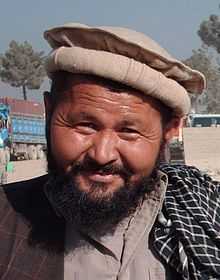Pakol

A pakol (Dari/Pashto/Chitrali: پکول), or the Afghan cap or Pashtun cap, is a soft, round-topped men's hat, typically of wool and found in any of a variety of earthy colors: brown, black, gray, or ivory, or dyed red using walnut.[1] Before it is fitted, it resembles a bag with a round, flat bottom. The wearer rolls up the sides nearly to the top, forming a thick band, which then rests on the head like a beret or cap. It is seen as a hat of all ethnic groups of Afghanistan.
Overview
Today it has become an integral part of Afghan and hippy culture all over the world. [2] It gained popularity among the northeastern Pashtun people in the early twentieth century. In the recent two decades it gain popularity in the Great tribal areas of Pakistan where it become their culture along with wasket particularly in winter.
The patti is first sewn into the shape of a cylinder, about a foot or more long. One end of the cylinder is capped with a round piece of the same material, slightly wider than the cylinder itself. The woolen cylinder is then inverted and fitted onto a round wooden block. The rim of the woolen cylinder is then rolled up to the top. The flat top protrudes a little over the rolled-up edge to give the cap a tiny brim. Otherwise, all Afghan headwear, unlike Western hats, is brimless. This is because Muslims pray with their heads covered. A brimmed hat would interfere with the sajdah (act of prostration during prayers). The little brim of the pakol, however, presents no such problem.
In Gilgit-Baltistan, the white color pakol is more popular and is sometimes worn with a peacock plume stuck in the folds, like a badge, on the front or the side of the cap. The deep blue and green of the peacock feather, set against the white of the cap, is quite eye catching.
Because of the woolen material, the pakol is basically a cold weather cap. In particularly chilly weather of Nuristan, the cap can be unrolled and pulled down over the ears, like a ski cap. Worn this way, it may look sloppy but is effective against the cold. The Afghan military leader Ahmad Shah Massoud is often shown in photographs wearing a pakol.
See also
- Peshawari Pagri
References
- ↑ "Terrorism, power outages hit Patti business hard". International The News. October 23, 2010.
- ↑ Ian Worthington, Nicholas Geoffrey Lemprière Hammond, Ventures into Greek history, p. 135, Clarendon Press, 1994
External links
- Willem Vogelsang, 'The Pakol: A distinctive, but apparently not so very old headgear from the Indo-Iranian borderlands'. Khil`a. Journal for Dress and Textiles of the Islamic World, Vol. 2, 2006, pp. 149–155.
| Wikimedia Commons has media related to Pakol. |